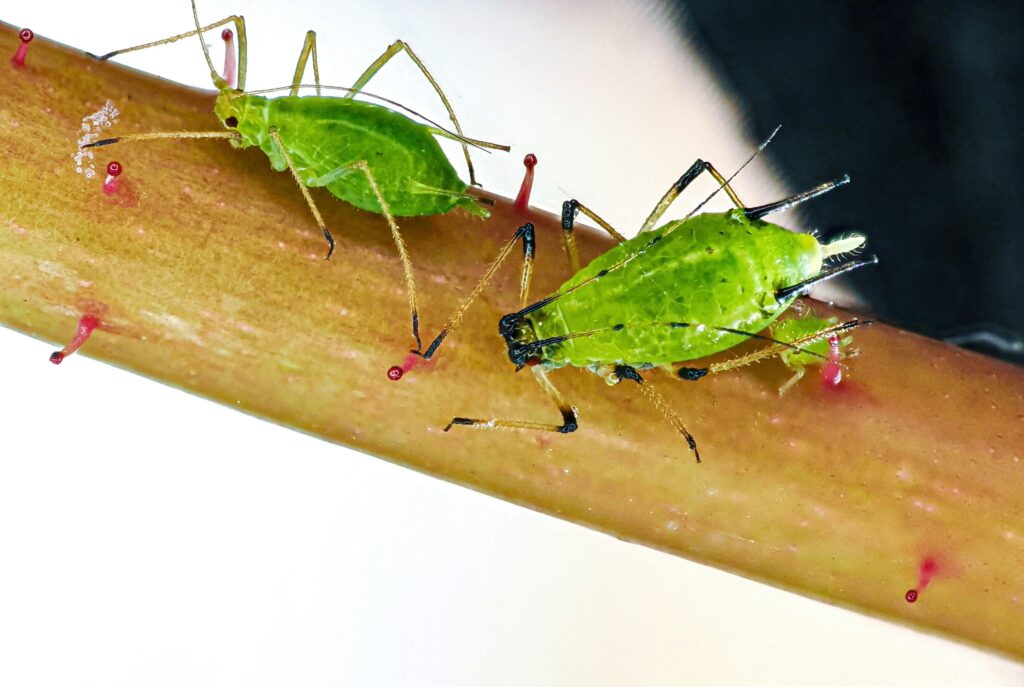In the vast realm of insects, some species possess remarkable abilities that border on the fantastical. Among these extraordinary capabilities is bioelectrogenesis – the biological generation of electricity. While electric eels and certain fish species are well-known for their shocking abilities, the electrical capabilities of insects have remained relatively obscure in public knowledge. These tiny creatures, through specialized organs and unique physiological adaptations, can generate, detect, and utilize electrical charges for various purposes ranging from communication to predation. As our world increasingly seeks sustainable energy alternatives, scientists are turning their attention to these voltage-generating insects for inspiration. This article explores the fascinating world of electric insects and the potential applications their natural electricity-generating mechanisms hold for human technology.
The Science Behind Bioelectricity in Insects

Bioelectricity in insects stems from the fundamental electrochemical properties of cells. At its core, this phenomenon relies on ion gradients across cell membranes, particularly the movement of sodium, potassium, and calcium ions. In insects with bioelectric capabilities, specialized cells called electrocytes are stacked in series, similar to batteries in a flashlight, amplifying the small voltages generated by each cell. These electrocytes possess an abundance of ion channels and pumps that facilitate rapid ion movement across membranes. When stimulated, these cells create a cascade effect, generating a measurable electric potential. Unlike vertebrate bioelectricity, which often requires substantial tissue mass, insects have evolved remarkably efficient systems that produce significant voltages despite their diminutive size, demonstrating nature’s engineering prowess at the microscale.
Click Beetles: The Original Electric Jumpers
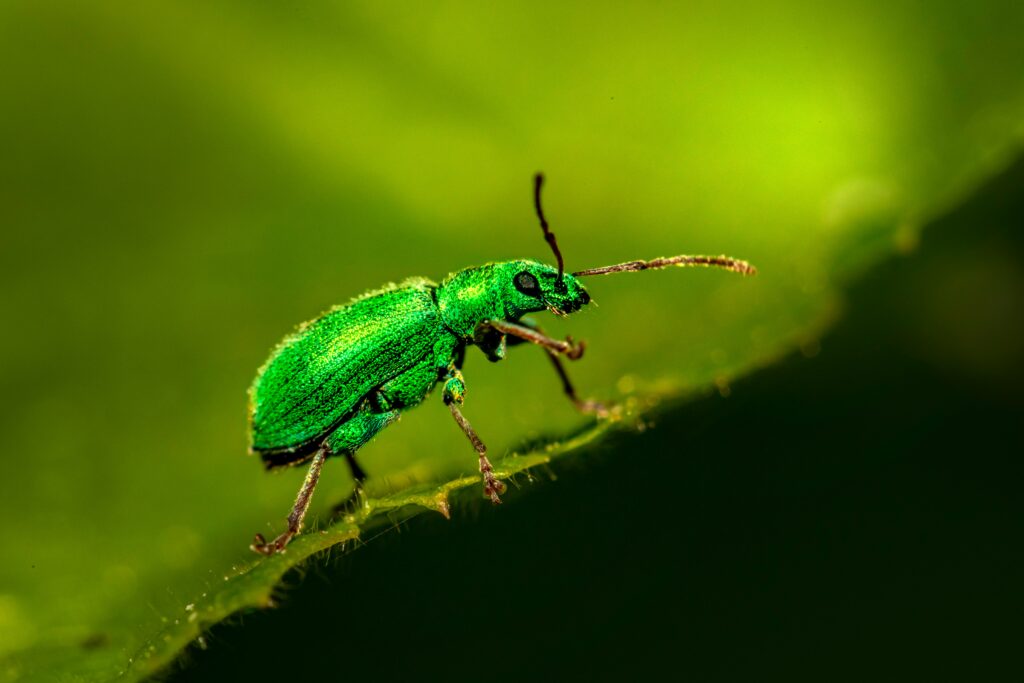
Click beetles (Elateridae family) represent one of the most fascinating examples of insects utilizing electrical energy for mechanical purposes. When these beetles find themselves upside down, they employ a unique mechanism to right themselves – an electrical muscle contraction that produces their characteristic “click” sound and propels them into the air. This process begins with the beetle arching its body, creating tension between a spine on its prothorax and a matching groove on its mesothorax. Specialized muscles build up electrical potential until a threshold is reached, releasing the energy explosively. The resulting snap can launch the beetle up to 30 centimeters into the air – equivalent to a human jumping over a skyscraper. Remarkably, this process generates voltages of up to 0.8V and accelerations exceeding 400g, making it one of the most electrically efficient movement mechanisms in the insect world.
Electric Fireflies: Bioluminescence and Bioelectricity
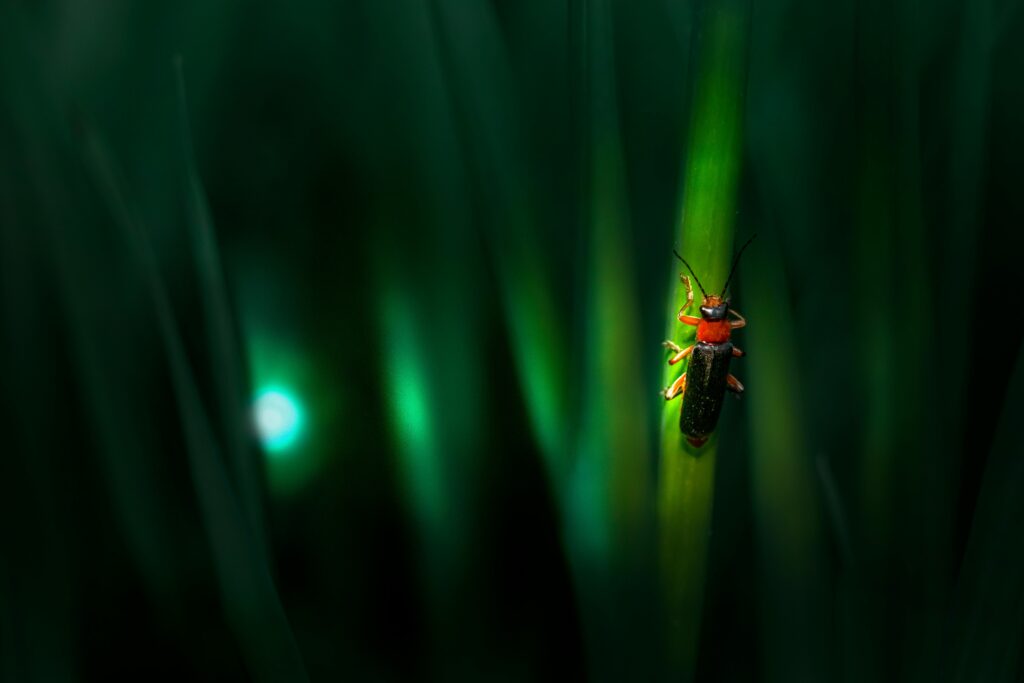
Fireflies (family Lampyridae) exemplify the fascinating intersection of bioelectricity and bioluminescence. Their iconic light displays aren’t simply chemical reactions but are precisely controlled by bioelectric signals. Within specialized light-producing organs called photophores, fireflies generate electrical potentials that trigger the oxidation of luciferin (a light-emitting compound) by the enzyme luciferase. This process is regulated by the insect’s nervous system, which sends electrical signals to initiate or cease light production. Particularly impressive is how some firefly species synchronize their flashing patterns across entire colonies, creating spectacular light shows through bioelectric coordination. This synchronization depends on pacemaker neurons that generate rhythmic electrical pulses, similar to how a cardiac pacemaker regulates heartbeats. Recent research has revealed that these insects can modulate the voltage across their photocyte membranes to produce different light intensities and colors, demonstrating sophisticated bioelectric control systems.
Oriental Hornets: Solar-Powered Electric Generators
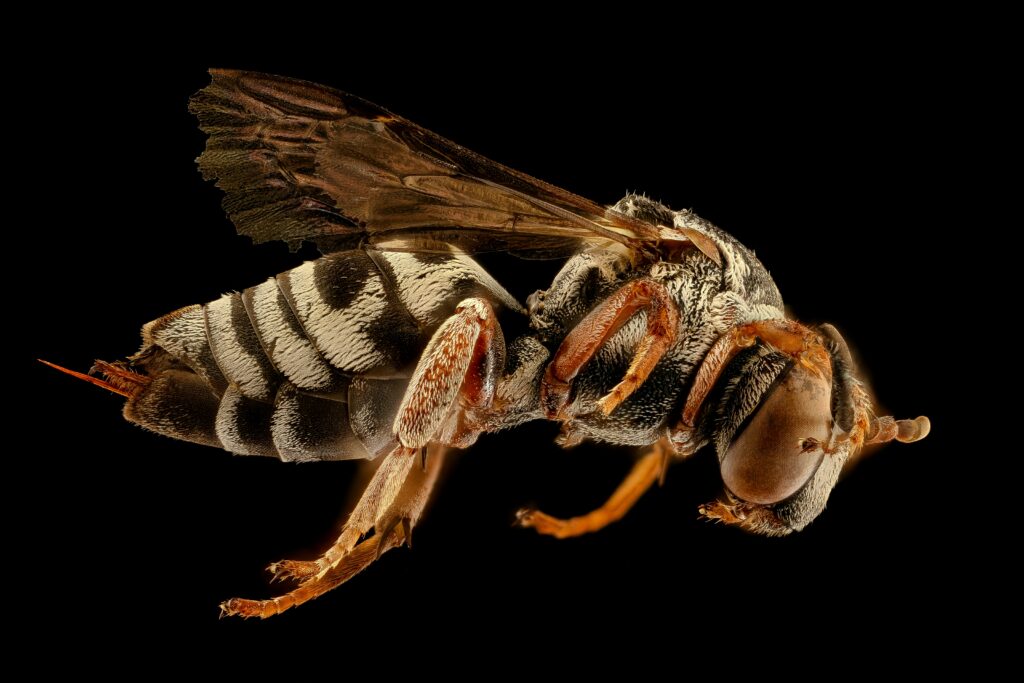
The Oriental hornet (Vespa orientalis) possesses one of the most remarkable bioelectric adaptations in the insect world – the ability to convert sunlight into electrical energy. Unlike most hornets that are less active during peak sunlight hours, Oriental hornets become more energetic, thanks to a specialized structure in their exoskeleton. Their brown cuticle contains xanthopterin, a light-sensitive pigment that absorbs solar radiation and converts it to electrical potential. Even more impressive is the yellow band on their abdomen, which contains microscopic structures similar to natural solar cells. These structures trap light through multiple reflections, enhancing energy absorption efficiency. Researchers have measured electrical potentials of up to 200-300 millivolts across the hornet’s exoskeleton during sun exposure. This solar-harvesting capability allows the hornets to maintain higher metabolic activity during hot days and potentially contributes to temperature regulation within their colonies, demonstrating an evolutionary adaptation that parallels human solar technology.
Electric Bombardier Beetles: Chemical Reaction Batteries

Bombardier beetles (family Carabidae) have evolved one of the most sophisticated defensive mechanisms in the insect world, one that generates measurable electrical potential as a byproduct. These beetles produce a boiling hot, caustic spray by mixing hydroquinones and hydrogen peroxide with catalytic enzymes in a specialized chamber. This violent chemical reaction not only produces the defensive spray but also creates an electrical potential difference of up to 0.5 volts across the reaction chamber. The electrical charge is generated through the rapid movement of ions during this exothermic reaction, essentially functioning as a miniature battery that charges during the defensive discharge. Remarkably, the beetle can control the direction and intensity of this spray with exceptional precision, suggesting neural control over the electrical aspects of the reaction. Researchers have documented that the electrical potential precedes the actual chemical ejection, indicating it may serve as part of the triggering mechanism for this sophisticated defense system.
Honeybees and Electric Field Detection
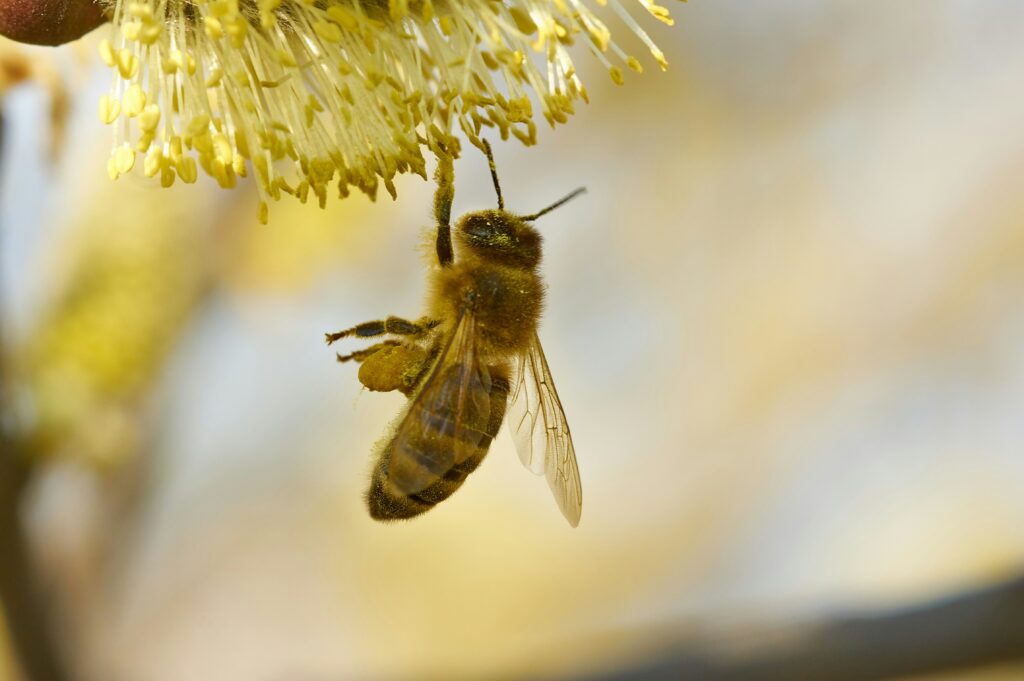
Honeybees (Apis mellifera) represent a fascinating case of insects that both generate and detect electrical fields as part of their communication system. During flight, bees accumulate a positive electrical charge up to 200 volts through friction with air molecules, similar to how walking across a carpet can generate static electricity. When a bee approaches a flower, this positive charge interacts with the flower’s negative charge, facilitating the transfer of pollen. More remarkably, researchers have discovered that bees can detect electric fields through specialized hair sensors (mechanoreceptors) that move in response to electric force. These hairs connect to neurons that transmit electrical signals to the bee’s brain. Experiments have shown that bees can be trained to distinguish between different electric field patterns, suggesting they use this information during foraging and hive communication. This electric sense adds another dimension to the already complex communication system of honeybees, which includes their famous waggle dance and pheromone signaling.
Electric Cockroaches: Nervous System Generators
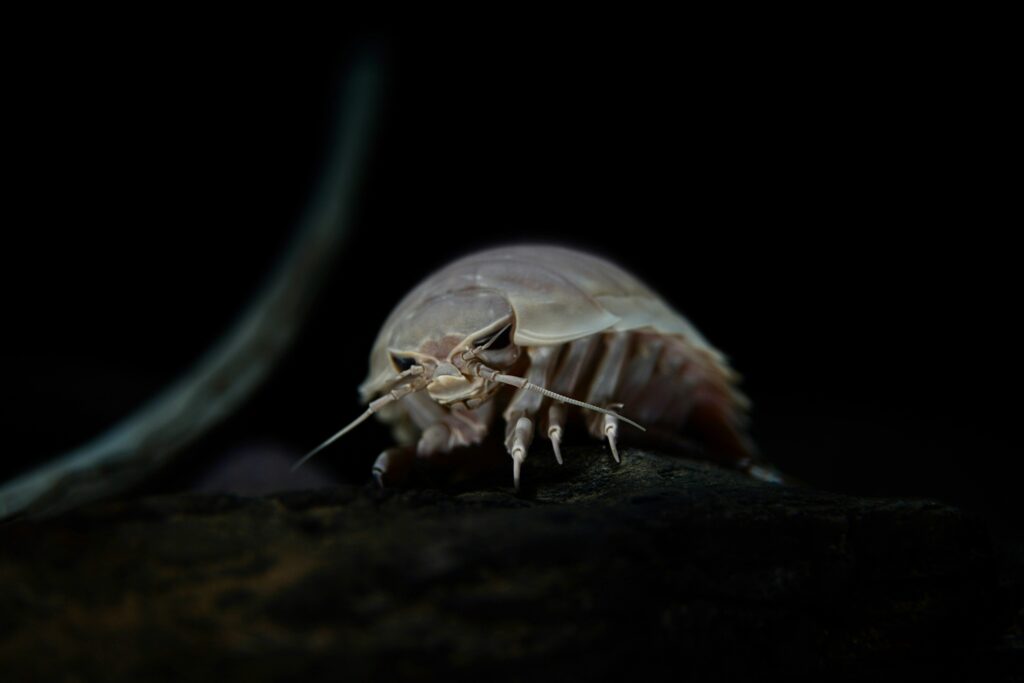
Cockroaches, particularly the American cockroach (Periplaneta americana), possess remarkably dense neural networks that generate measurable electrical activity. Their central nervous system produces electrical potentials of up to 9 millivolts during normal activity, with significant spikes during stress or escape responses. This electrical generation is particularly concentrated in their cerci – the sensory appendages at the rear of the abdomen – which contain thousands of highly sensitive mechanoreceptors that detect air movement through electrical signaling. What makes cockroach bioelectricity particularly interesting to researchers is its resilience; cockroach neurons can continue generating electrical potentials even after significant damage to the insect. This neural electrical activity is so robust that researchers have successfully used cockroach nervous systems as living components in simple electronic circuits. Recent experiments have demonstrated that arrays of cockroach neurons can be used to process signals in ways similar to transistors, opening possibilities for bio-hybrid electronic systems that combine the efficiency of biological processing with conventional electronics.
Electric Caterpillars: Defensive Voltage Generation
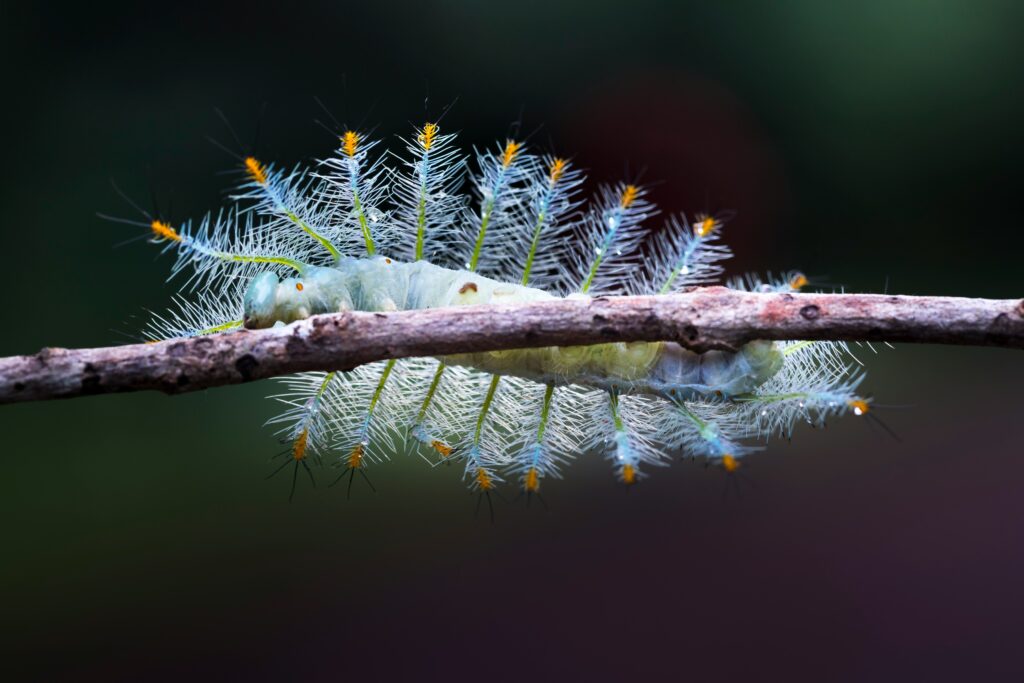
Certain caterpillar species, particularly within the Limacodidae family (slug caterpillars), have evolved remarkable defensive mechanisms involving electrical voltage generation. These caterpillars possess specialized urticating spines containing venom glands that, when disturbed, generate electrical potentials of up to 0.2 volts. This voltage serves a dual purpose: it helps deliver venom through the spine and creates an additional deterrent through a mild electric shock sensation. The electric potential is generated through a rapid ion exchange mechanism triggered by mechanical stress on the spine. Researchers studying these caterpillars have discovered that the electrical component of their defense is particularly effective against avian predators, whose nervous systems are highly sensitive to electrical stimulation. Perhaps most fascinating is the caterpillar’s ability to modulate this voltage depending on the threat level, generating stronger electrical potentials when subjected to persistent disturbance. This sophisticated defense system demonstrates how even larval insects can evolve complex bioelectric mechanisms for survival.
Longhorn Beetles and Electrical Tympanic Organs
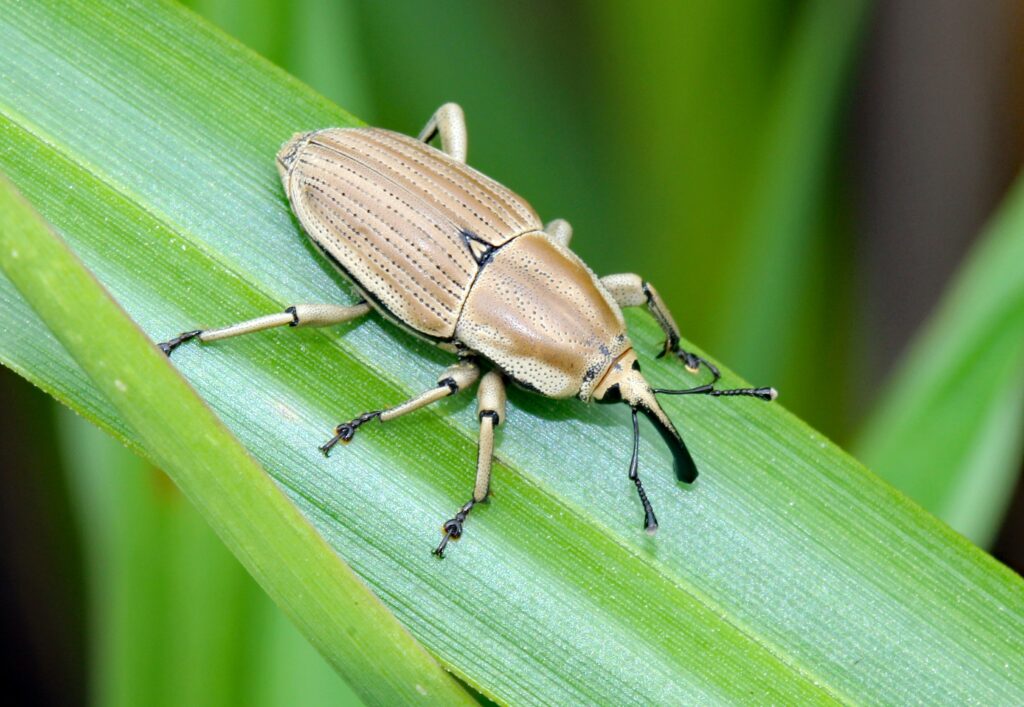
Certain species of longhorn beetles (Cerambycidae family) possess specialized tympanic organs that not only detect sound but also generate electrical potentials in response to specific frequencies. Unlike most insect auditory systems, these beetles can produce small counter-voltages of up to 0.1 millivolts when their tympanic membranes vibrate at certain resonant frequencies. This unusual mechanism appears to serve as a form of active noise cancellation, allowing the beetles to filter out background noise while remaining sensitive to sounds produced by potential mates or predators. The electrical generation occurs through specialized mechanoreceptor cells that convert mechanical vibration energy into electrical signals through piezoelectric properties in their cell membranes. Recent research suggests that this electric response may be tunable, with beetles able to adjust their electrical sensitivity based on environmental conditions. This sophisticated system represents a remarkable example of how insects have evolved bioelectric mechanisms for sensory processing that parallel technologies humans only developed in the late 20th century.
Bioengineering Applications: Insect-Inspired Energy Harvesting
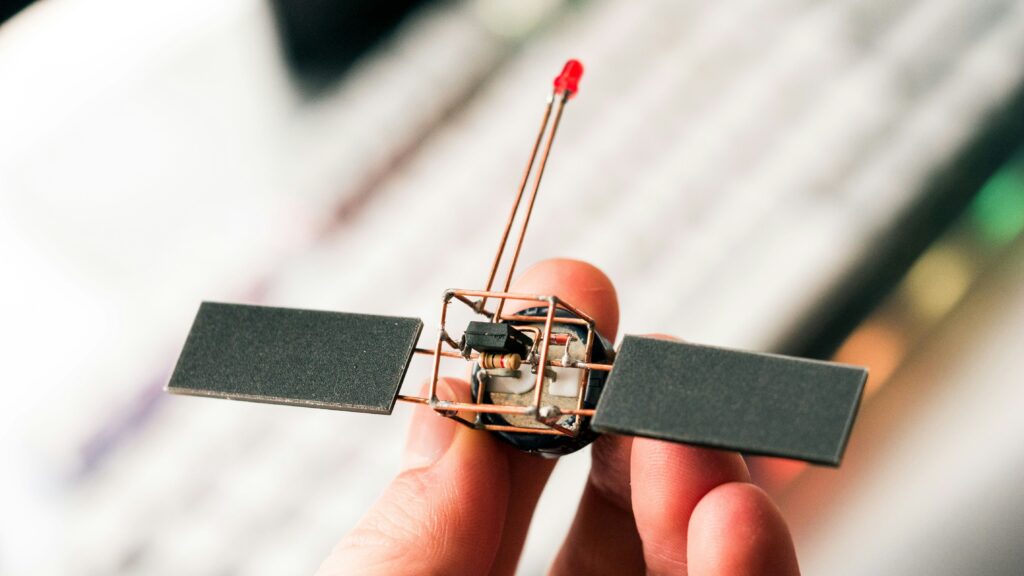
The electrical generating capabilities of insects have inspired numerous biomimetic technologies with promising applications. Researchers have developed piezoelectric generators based on the jumping mechanism of click beetles, creating devices that can harvest energy from vibrations in the environment. These mini-generators convert mechanical energy into electrical energy with efficiency approaching that of their biological counterparts. Similarly, the Oriental hornet’s natural solar cells have inspired more efficient photovoltaic designs, particularly for low-light conditions where conventional solar panels struggle. Engineers have created prototype “artificial hornet cuticle” with nanostructures mimicking those found on the hornet’s exoskeleton, achieving improved light absorption across the visible spectrum. Perhaps most promising are bio-hybrid systems that incorporate actual insect tissues or cells into electronic devices. Labs have successfully maintained electrogenic insect cells in culture and incorporated them into microcircuits, creating living power sources for ultra-low-power applications. These bio-inspired and bio-hybrid approaches represent a frontier in sustainable energy harvesting, particularly for applications requiring distributed, self-sustaining power sources.
Micro-Robotics: Powering the Next Generation of Tiny Machines
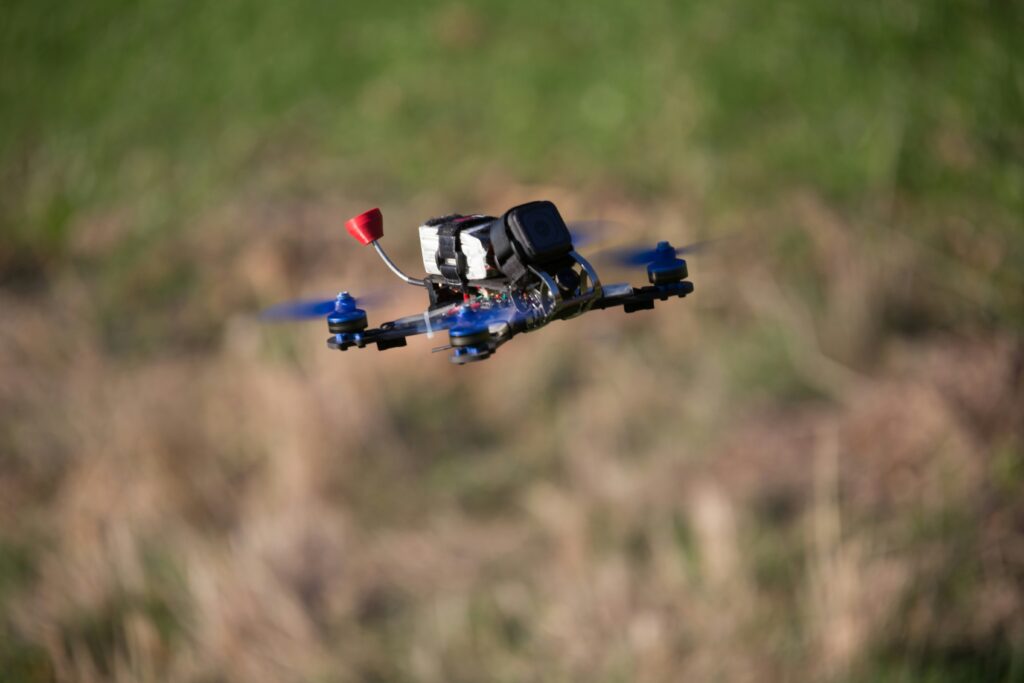
The field of micro-robotics faces a persistent challenge: how to power robots at the millimeter or sub-millimeter scale. Traditional batteries are too heavy and inefficient at these scales, making insect bioelectricity mechanisms particularly valuable as inspiration. Engineers have developed prototype micro-robots powered by artificial versions of the click beetle’s latch mechanism, capable of jumping heights over 100 times their body length using minimal power. Other researchers have created “electro-elastic” actuators based on the muscle systems of electric insects, achieving movement with power requirements orders of magnitude lower than conventional motors. Perhaps most ambitious are efforts to create entirely biological power systems for micro-robots, using cultured insect electrocytes maintained in nutrient solutions. These living power sources can generate consistent voltage for weeks with proper maintenance, offering potential applications in environmental monitoring, medical diagnostics, and search-and-rescue operations. As micro-fabrication techniques improve, we can expect increasingly sophisticated biomimetic and bio-hybrid power systems that blur the line between engineered systems and living organisms.
Medical Applications: From Biosensors to Neural Interfaces
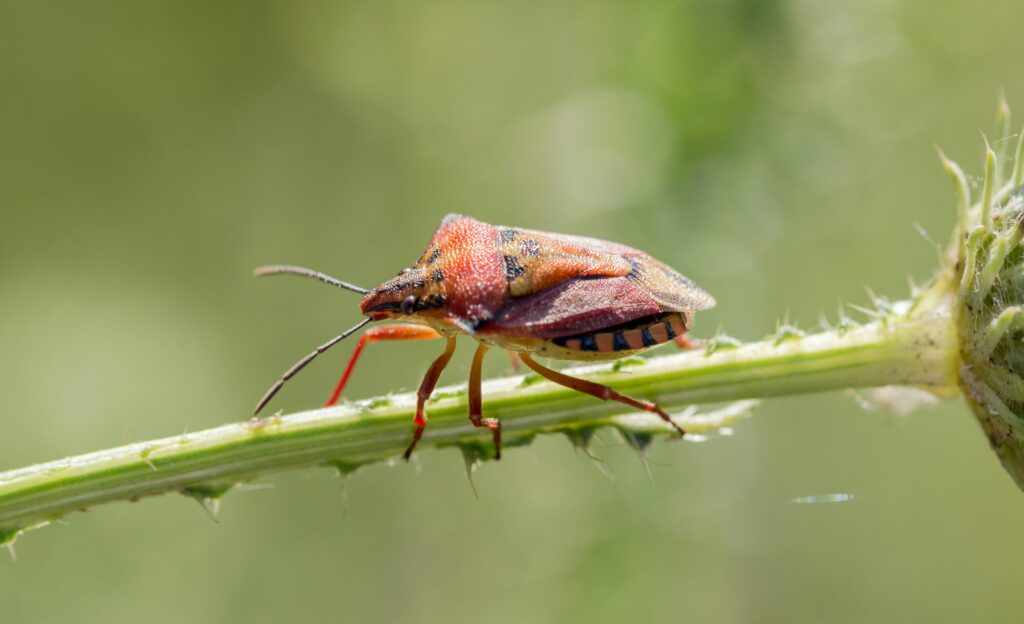
The bioelectric mechanisms of insects offer intriguing applications in medical technology, particularly for implantable devices requiring long-term, low-power operation. Researchers have developed glucose sensors based on modified versions of the electric signaling pathways found in honeybee neurons, creating devices that can detect blood sugar fluctuations with minimal power requirements. In neural interface technology, the highly efficient signal processing of insect ganglia has inspired new approaches to brain-computer interfaces that require significantly less power than conventional designs. Some experimental medical devices now incorporate elements of the bombardier beetle’s catalytic chambers to create self-powered drug delivery systems that generate small electrical potentials to drive medication release. Perhaps most promising is research into regenerative medicine inspired by the electrical healing mechanisms observed in certain insects. When damaged, the nervous systems of cockroaches generate specific electrical patterns that appear to guide tissue regeneration, a process researchers are now attempting to replicate for human nerve repair. These medical applications represent just the beginning of how insect bioelectricity might transform healthcare technology.
Environmental Monitoring: Electric Insects as Biosensors
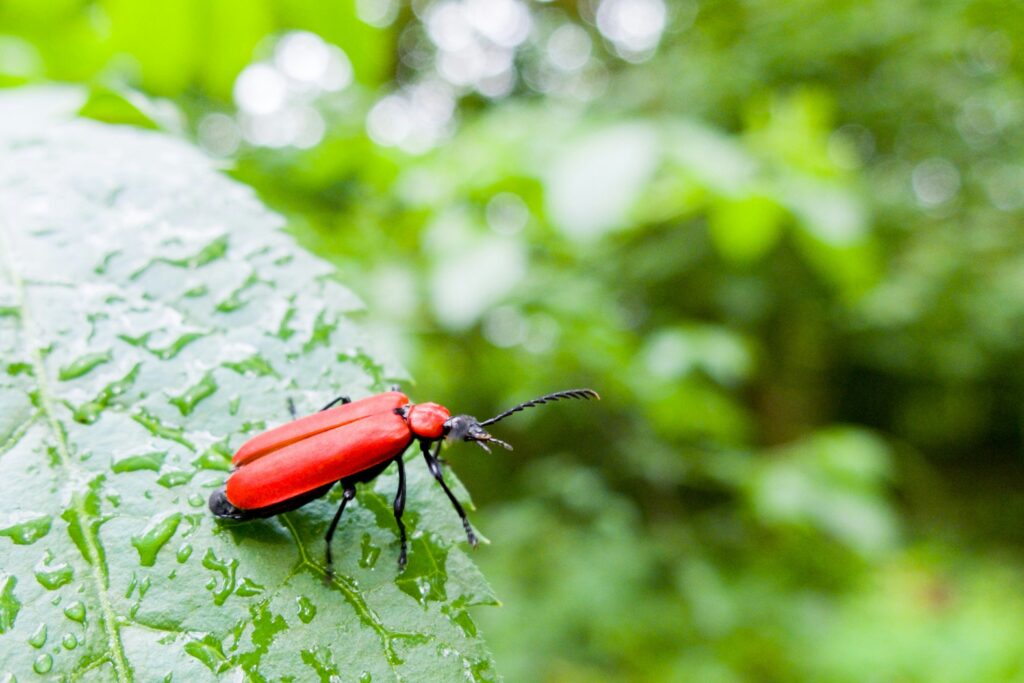
The electrical systems of insects demonstrate remarkable sensitivity to environmental conditions, making them valuable models for advanced biosensing technologies. Researchers have developed environmental sensors based on the mechanoreceptors of cockroach cerci, creating devices capable of detecting air movement as subtle as 0.1 mm/s – sufficient to monitor microchanges in airflow patterns that might indicate structural failures or gas leaks. Other teams have engineered biosensors inspired by the electrical properties of honeybee antennae, which can detect specific volatile organic compounds at parts-per-billion concentrations through changes in electrical conductance. These insect-inspired sensors operate with minimal power requirements and can function in harsh environments where traditional electronic sensors might fail. Particularly promising are distributed sensor networks that mimic colony insects’ collective electrical sensing, creating systems that can monitor environmental conditions across large areas with unprecedented detail and efficiency. As climate monitoring becomes increasingly crucial, these bioelectric sensing approaches offer sustainable alternatives to conventional sensor technologies, potentially enabling continuous environmental monitoring with minimal resource requirements.
Challenges and Future Directions in Harnessing Insect Bioelectricity
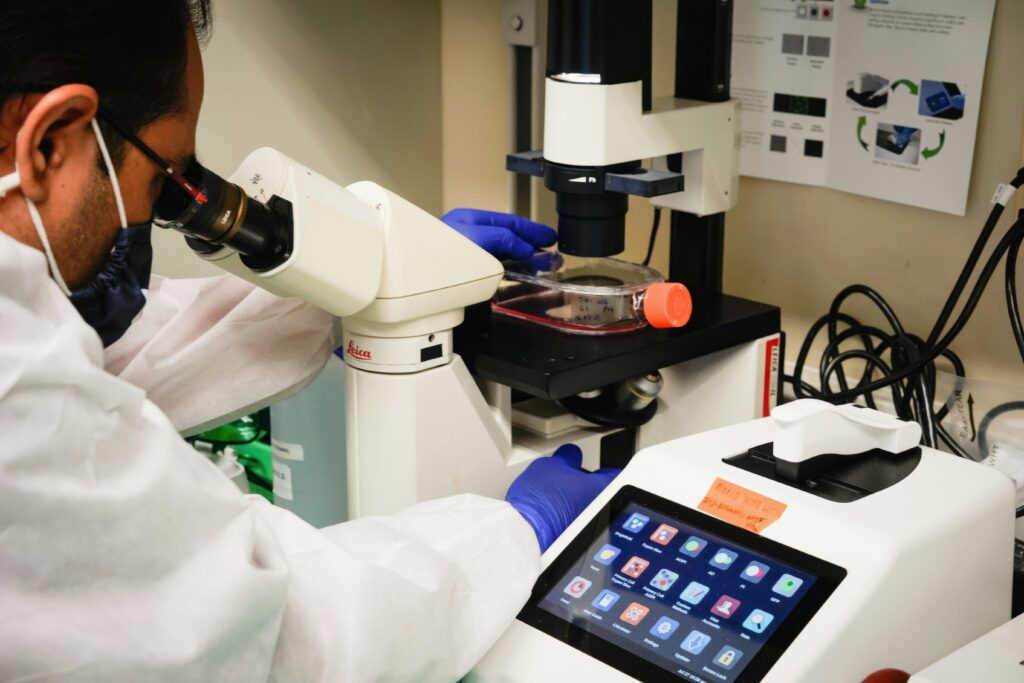
Despite the promising applications of insect bioelectricity, significant challenges remain before widespread practical implementation becomes possible. One fundamental challenge is scalability – while insect mechanisms work perfectly at the microscale, creating manufacturable technologies based on these principles requires overcoming significant engineering hurdles. Stability presents another obstacle, as biological systems typically require specific environmental conditions that may be difficult to maintain in practical applications. Researchers are exploring various approaches to address these challenges, including the development of synthetic biology techniques to create modified insect cells with enhanced stability and output. Another promising direction involves hybrid systems that combine biological components with traditional electronics, leveraging the advantages of both. Looking forward, the field of insect bioelectricity stands at a fascinating intersection of entomology, electrical engineering, materials science, and synthetic biology. As these disciplines continue to converge, we can anticipate increasingly sophisticated technologies that not only mimic insect capabilities but potentially enhance them, creating sustainable bioelectric systems with applications ranging from medicine to environmental monitoring and beyond.
Conclusion: The Electric Future Inspired by Tiny Creatures
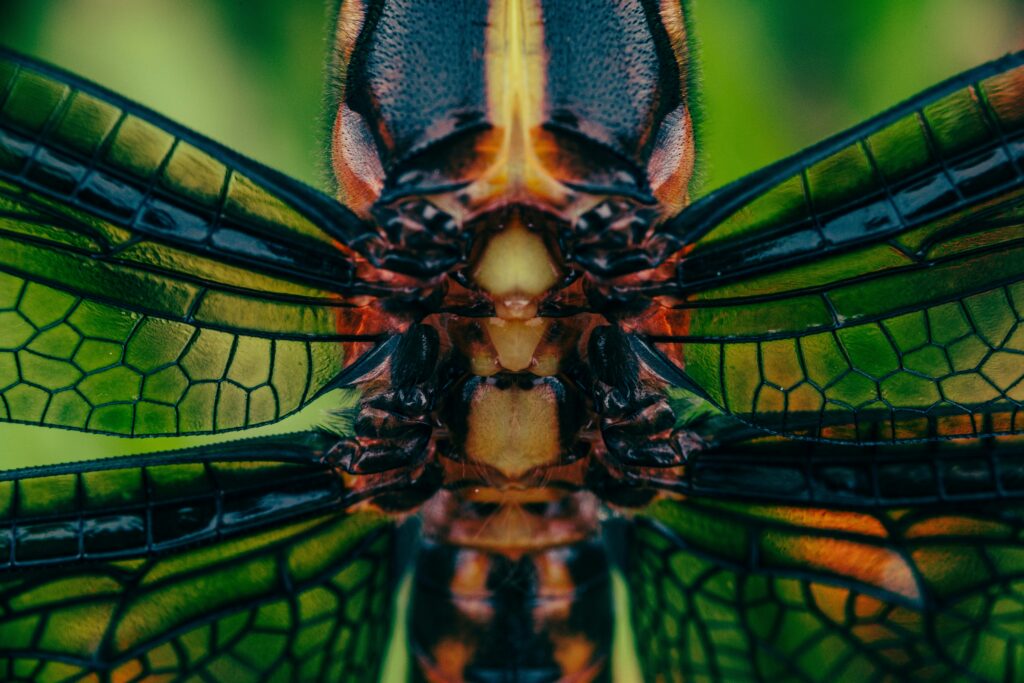
The electrical capabilities of insects represent one of nature’s most remarkable yet underappreciated evolutionary achievements. These tiny creatures have developed sophisticated bioelectric mechanisms for communication, defense, and sensory processing that often surpass human technology in efficiency and elegance. As we continue to study and understand these systems, they offer valuable blueprints for addressing some of humanity’s most pressing technological challenges – from sustainable energy generation to medical devices and environmental monitoring. While practical applications of insect bioelectricity remain largely in experimental stages, the rapid advancement of biomimetic engineering and synthetic biology suggests a future where the line between technological and biological systems increasingly blurs. The electric bug – once merely a curiosity of natural history – may well become a cornerstone of next-generation sustainable technology. In the elegant efficiency of these small creatures, we find not only fascinating biology but also potential solutions to some of our grandest engineering challenges.

